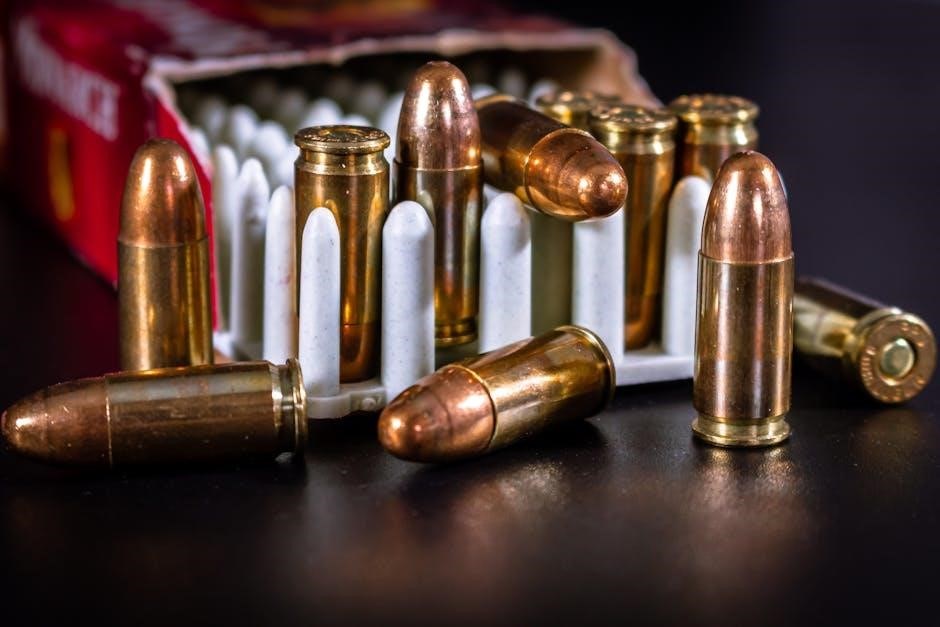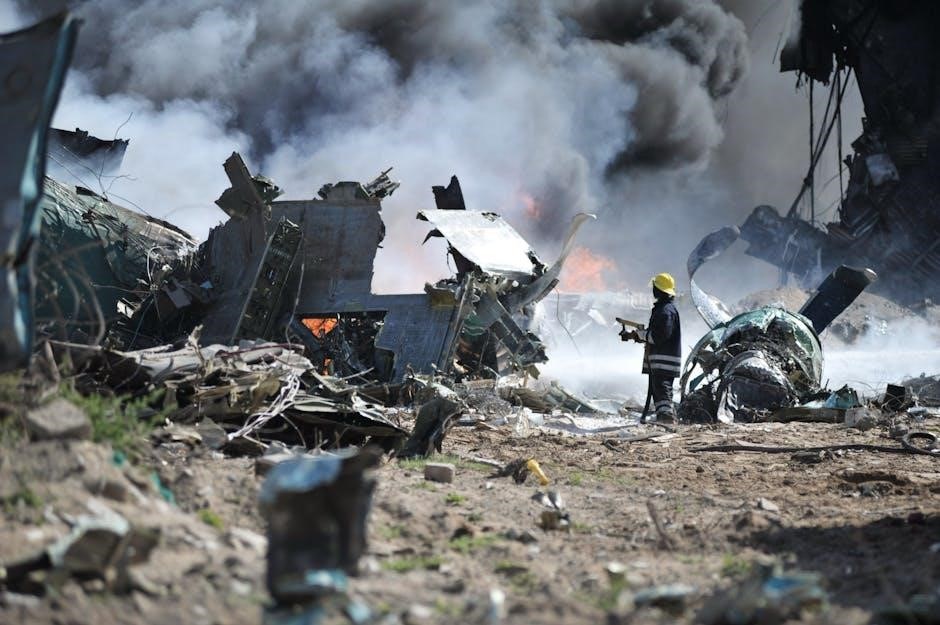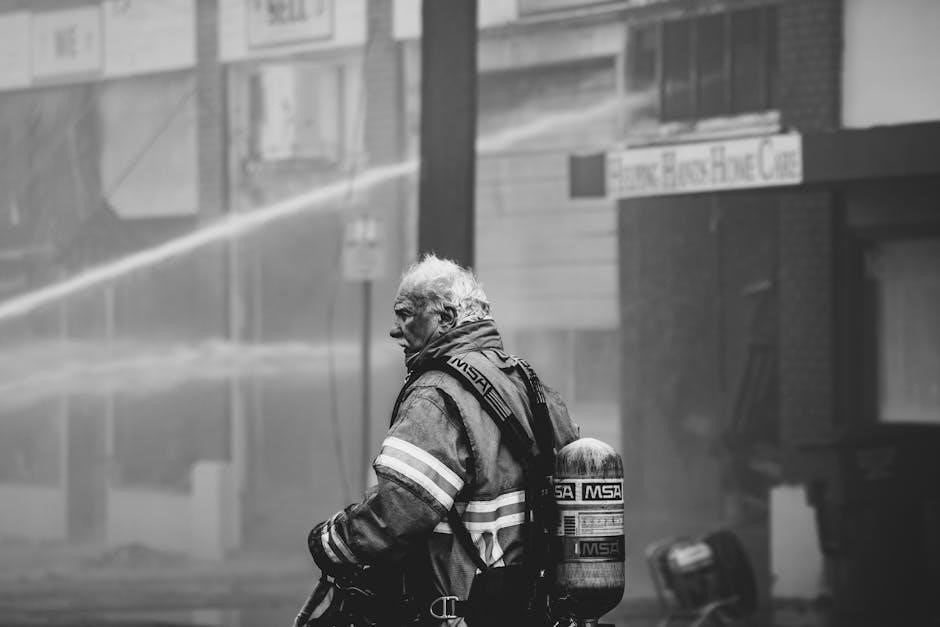NFPA 268 provides a standardized test method for assessing the ignitability of exterior wall assemblies using radiant heat energy, ensuring fire safety in construction materials․
1․1 Overview of the Standard
NFPA 268 is a standardized test method developed by the National Fire Protection Association (NFPA) to determine the ignitability of exterior wall assemblies using a radiant heat energy source․ The standard provides a controlled laboratory test to assess how exterior walls respond to radiant heat, simulating real-world fire exposure․ It specifies the setup, including the application of a fixed incident radiant heat flux of 12․5 kW/m² for 20 minutes․ The test evaluates whether the assembly ignites or sustains flaming, with criteria such as no ignition within the exposure period and no sustained flaming exceeding 5 seconds․ This method is crucial for ensuring fire safety in construction materials and aligns with building code requirements․
1․2 Importance of Fire Safety in Construction
Fire safety in construction is critical to protect lives, property, and the environment from fire hazards․ NFPA 268 plays a key role by providing a standardized method to assess the ignitability of exterior wall assemblies, ensuring materials can withstand radiant heat exposure․ This helps prevent the spread of fires and reduces potential damage․ Compliance with such standards is essential for meeting building codes and regulations, which are designed to safeguard public safety․ By testing materials under controlled conditions, NFPA 268 contributes to the development of fire-resistant construction practices, ultimately saving lives and reducing economic losses from fires․ Adhering to these standards is vital for creating safer buildings and communities․
1․3 Purpose of NFPA 268
NFPA 268 is designed to determine the ignitability of exterior wall assemblies when exposed to radiant heat energy․ Its primary purpose is to evaluate how materials respond to fire hazards, ensuring they meet safety standards․ The standard specifies testing protocols, including exposure to a radiant heat flux of 12․5 kW/m² for 20 minutes, with criteria for ignition resistance and sustained flaming․ By providing clear test methods, NFPA 268 helps architects, builders, and material manufacturers select fire-resistant products․ This ensures compliance with building codes and enhances fire safety in construction projects․ The standard is essential for identifying materials that can withstand radiant heat, thereby reducing fire risks and protecting lives and property․

Purpose and Scope of NFPA 268
NFPA 268 outlines the application of radiant heat testing to assess exterior wall assemblies, ensuring materials meet fire safety standards in construction projects through specific ignition criteria․
2․1 Defining Ignitability of Exterior Wall Assemblies
NFPA 268 focuses on determining the ignitability of exterior wall assemblies by exposing them to a radiant heat energy source․ The standard defines ignitability as the ability of a material to catch fire under specific conditions․ It measures how exterior walls respond to radiant heat flux, typically set at 12․5 kW/m², over a 20-minute period․ The test evaluates whether the assembly ignites, sustains flames, or resists fire․ This method ensures materials meet fire safety requirements, helping to prevent fire spread in buildings․ By establishing clear ignition criteria, NFPA 268 aids in selecting fire-resistant materials for construction, ensuring compliance with safety standards and protecting against fire hazards․
2․2 Radiant Heat Energy Source in Testing
NFPA 268 employs a radiant heat energy source to simulate real-world fire conditions, ensuring accurate testing of exterior wall assemblies․ The standard specifies a fixed incident radiant heat flux of 12․5 kW/m², applied for 20 minutes․ This controlled exposure helps determine the material’s ignition resistance and flame spread characteristics․ The radiant heat source is designed to mimic the thermal exposure from an adjacent fire, providing a consistent and repeatable test environment․ By standardizing the heat flux and duration, NFPA 268 ensures reliable results, enabling comparisons across different materials and assemblies․ This method is crucial for evaluating how exterior walls perform under fire conditions, ensuring compliance with safety standards and protecting against fire hazards in buildings․
2․3 Application of the Standard in Construction
NFPA 268 is widely applied in construction to ensure exterior wall assemblies meet fire safety requirements․ The standard is used to test materials and designs, helping architects and builders select fire-resistant components․ By determining ignition resistance and flame spread, it guides the development of safer building envelopes․ Compliance with NFPA 268 is often mandated by local building codes, ensuring consistency in fire safety across constructions․ This standard is particularly valuable for high-rise buildings and structures in fire-prone areas, where exterior walls are critical in preventing fire spread․ Its application promotes the use of fire-resistant materials, enhancing overall building safety and protecting lives and property from fire hazards․
Test Method Details
NFPA 268 details a test method using radiant heat to measure ignitability of exterior walls, ensuring fire safety in construction materials and designs, aiding compliance․
3․1 Setup and Configuration of the Test
The test setup for NFPA 268 involves a radiant heat energy source directed at the exterior wall assembly specimen․ The apparatus is calibrated to ensure uniform heat flux application․ Specimens are mounted vertically, and thermocouples are placed to monitor surface temperatures․ The test chamber is configured to minimize external interference, ensuring accurate measurements․ A radiant heat flux of 12․5 kW/m² is applied for 20 minutes, as specified․ The setup includes a ignition source to assess the material’s response to heat exposure․ Proper configuration ensures the test accurately evaluates the ignitability and flame spread characteristics of the assembly, aligning with fire safety standards․

3․2 Conducting the Test with Radiant Heat Flux
Conducting the NFPA 268 test involves exposing the exterior wall assembly to a controlled radiant heat flux of 12․5 kW/m² for 20 minutes․ The heat source is applied uniformly to ensure consistent test conditions․ Observations are made to detect ignition, sustained flaming, or flame spread․ Thermocouples monitor surface temperatures throughout the test․ The specimen is evaluated for its ability to resist ignition under the specified heat flux․ The test procedure ensures accurate assessment of the material’s fire performance․ Data collected during the test is used to determine compliance with the standard’s acceptance criteria, focusing on ignition resistance and flame propagation characteristics․
3․3 Exposure Duration and Measurement Criteria
The NFPA 268 test exposes exterior wall assemblies to a radiant heat flux of 12․5 kW/m² for 20 minutes․ The duration ensures sufficient time to assess ignition resistance․ Measurements focus on whether ignition occurs within the exposure period․ Sustained flaming is recorded if it exceeds 5 seconds․ Flame spread is also monitored to evaluate material performance․ Thermocouples are used to track temperature changes on the specimen’s surface․ The criteria aim to determine if the assembly can withstand ignition under prolonged radiant heat․ No ignition should occur during the 20-minute exposure to meet the standard’s requirements․ This ensures the material’s fire resistance is reliably assessed for safety in construction applications․

Acceptance Criteria
NFPA 268 sets acceptance criteria requiring no ignition under 12․5 kW/m² radiant heat for 20 minutes and limits sustained flaming to a maximum of 5 seconds․
4․1 Sustained Flaming and Ignition Resistance
NFPA 268 establishes criteria for sustained flaming and ignition resistance, requiring exterior wall assemblies to withstand radiant heat without igniting or sustaining flames beyond 5 seconds․ The standard mandates that no ignition occurs when exposed to a radiant heat flux of 12․5 kW/m² for 20 minutes․ This ensures materials resist fire spread and maintain structural integrity․ Sustained flaming is strictly limited to prevent rapid fire propagation, enhancing safety in construction․ Compliance with these criteria is critical for reducing fire hazards in buildings, protecting both occupants and property․ The test method is designed to simulate real-world fire conditions, ensuring reliable results for material evaluation․
4;2 Maximum Allowable Incident Radiant Heat Flux
NFPA 268 specifies the maximum allowable incident radiant heat flux for exterior wall assemblies during testing․ The standard sets a threshold of 12․5 kW/m², ensuring materials can withstand this intensity without igniting or sustaining flames․ This criterion is critical for evaluating fire resistance and preventing rapid fire spread․ The radiant heat flux is applied for 20 minutes, simulating real-world fire exposure․ Materials must not exhibit sustained flaming or ignition within this period to meet compliance․ This parameter ensures that building materials can endure extreme heat conditions, safeguarding structures and occupants from fire hazards; The strict limit on radiant heat flux is a cornerstone of NFPA 268, promoting enhanced fire safety in construction․

Significance of NFPA 268 in Fire Safety
NFPA 268 ensures fire safety by setting criteria for exterior wall assemblies, preventing ignition and flame spread, thus protecting lives and property in construction projects․
5․1 Ensuring Compliance with Building Codes
NFPA 268 plays a crucial role in ensuring that exterior wall assemblies meet building code requirements, particularly for fire safety․ By providing a standardized test method, it helps verify that materials and systems can withstand radiant heat exposure without igniting or spreading flames․ This compliance is essential for adhering to regulations like the International Building Code (IBC), which often references NFPA standards․ The test evaluates assemblies under controlled conditions, ensuring they perform as expected in real fire scenarios․ Compliance with NFPA 268 not only satisfies regulatory demands but also enhances public safety by minimizing fire risks in construction projects․
5․2 Protecting Lives and Property from Fire Hazards
NFPA 268 is instrumental in safeguarding lives and property by establishing rigorous fire safety standards for exterior wall assemblies․ The standard ensures materials and systems resist ignition and prevent flame spread under radiant heat exposure․ By setting clear criteria for sustained flaming and ignition resistance, NFPA 268 helps mitigate fire hazards in buildings․ This protection is critical in preventing catastrophic fires that could lead to loss of life and property damage․ The standard’s focus on precise testing and measurement provides reliable data, enabling better decision-making for safer construction practices․ Ultimately, NFPA 268 contributes to reducing fire-related risks and ensuring a higher level of safety in built environments․
Applications of NFPA 268
NFPA 268 is applied in construction and architectural design to ensure fire safety and aid in developing fire-resistant materials, promoting safer building practices․

6․1 Use in Construction and Architectural Design
NFPA 268 plays a critical role in construction and architectural design by providing a standardized method to evaluate exterior wall assemblies’ resistance to ignition from radiant heat․ This ensures materials used in building facades meet fire safety requirements, reducing the risk of fire spread․ Architects and contractors rely on NFPA 268 to select materials that comply with fire safety regulations․ The test method involves exposing wall assemblies to a radiant heat flux of 12․5 kW/m² for 20 minutes, with criteria requiring no ignition or sustained flaming․ This process helps design safer buildings and ensures compliance with fire safety standards in the construction industry․
6․2 Role in Fire-Resistant Material Development
NFPA 268 significantly contributes to the development of fire-resistant materials by providing a rigorous testing protocol to assess their performance under radiant heat exposure․ Manufacturers use this standard to evaluate how exterior wall assemblies withstand ignition when exposed to specific heat flux levels․ The test results guide material innovations, ensuring products meet fire safety requirements․ By establishing clear criteria for ignition resistance, NFPA 268 helps manufacturers refine their materials, leading to the creation of more fire-resistant products․ This process supports advancements in material science and enhances the safety of buildings by reducing fire hazards․ The standard is instrumental in driving the development of materials that comply with fire safety regulations and protect lives and property․
Comparison with Other Fire Safety Standards
NFPA 268 differs from NFPA 285 and IBC by using a fixed radiant heat flux for testing exterior wall assemblies, ensuring consistent fire safety evaluations․
7․1 NFPA 268 vs․ NFPA 285
NFPA 268 and NFPA 285 are both fire safety standards but serve different purposes․ NFPA 268 focuses on determining the ignitability of exterior wall assemblies using radiant heat, while NFPA 285 addresses fire propagation on combustible exterior wall assemblies․ Unlike NFPA 268, which uses a fixed radiant heat flux, NFPA 285 incorporates variable testing conditions to simulate real-world fire scenarios․ NFPA 268 is primarily concerned with ignition resistance, whereas NFPA 285 evaluates the spread of fire on exterior walls․ Both standards complement each other but are applied in different contexts to ensure comprehensive fire safety in construction materials and designs․

7․2 Differences in Testing Methods and Criteria

NFPA 268 and NFPA 285 differ in their testing methods and criteria․ NFPA 268 uses a fixed incident radiant heat flux of 12․5 kW/m² for 20 minutes to assess ignitability, focusing on sustained flaming and ignition resistance․ In contrast, NFPA 285 employs variable testing conditions to evaluate fire propagation on exterior walls․ NFPA 268 measures ignition resistance, while NFPA 285 assesses flame spread and heat release․ The criteria for passing differ: NFPA 268 requires no ignition or sustained flaming, whereas NFPA 285 evaluates whether the fire spreads beyond the test assembly․ These differences reflect their distinct goals in fire safety evaluation․

Challenges and Limitations
NFPA 268’s fixed radiant heat flux testing may not align with variable conditions in other standards like IBC, potentially limiting its broader applicability and acceptance․
8․1 Variability in Test Results
Test results under NFPA 268 can vary due to differences in material properties, environmental conditions, and equipment calibration․ The fixed radiant heat flux may not account for real-world variability, leading to inconsistent outcomes․ Additionally, the 12․5 kW/m² exposure threshold and 20-minute duration may not capture all ignition scenarios, potentially affecting reliability․ Variability can also arise from differences in wall assembly configurations and material degradation over time․ While the standard provides a controlled testing environment, these factors can influence results, making it challenging to ensure uniformity across different tests and materials․ This variability underscores the need for careful test setup and interpretation to maintain accuracy and consistency․

8․2 Cost and Complexity of Testing
The NFPA 268 testing process involves significant costs and complexity, primarily due to the specialized equipment and trained personnel required․ The setup demands precise control over radiant heat flux and environmental conditions, adding to the expense․ Materials like foam plastics, as tested by companies such as Dow, require specific configurations, further complicating the process․ Access to certified testing laboratories is limited, creating barriers for smaller manufacturers․ These factors make NFPA 268 compliance resource-intensive, particularly for companies with limited budgets or expertise, highlighting the need for substantial investment in both technology and human resources to meet the standard’s rigorous requirements effectively․
NFPA 268 is a critical standard for ensuring fire safety by testing exterior wall assemblies’ ignitability, protecting lives and property through precise radiant heat energy assessments․
9․1 Summary of Key Points
NFPA 268 provides a standardized method to assess the ignitability of exterior wall assemblies using radiant heat energy․ It ensures materials meet fire safety requirements by testing their resistance to ignition under controlled conditions․ The standard specifies exposure to a radiant heat flux of 12․5 kW/m² for 20 minutes, with criteria for sustained flaming and ignition resistance․ Compliance with NFPA 268 helps prevent fire spread in buildings, protecting lives and property․ It is widely recognized for its role in fire safety, particularly in construction and material development, ensuring adherence to building codes and promoting the use of fire-resistant materials․
9․2 Future Developments in Fire Testing Standards
Future developments in fire testing standards, including NFPA 268, are expected to focus on advancing test methods and criteria to address emerging materials and construction techniques․ There may be increased emphasis on sustainability and environmental considerations in fire testing․ Digital tools and automation could enhance the accuracy and efficiency of testing processes․ Additionally, there may be efforts to harmonize fire safety standards across regions to facilitate international construction projects․ These advancements aim to improve fire safety outcomes while adapting to evolving building practices and material innovations, ensuring continued protection of lives and property in the face of new challenges․

Be First to Comment